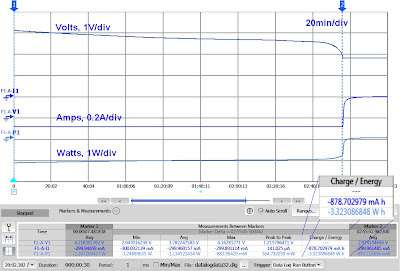A second aspect of optimizing battery run-time is making
certain you are making optimum use of the battery powering the device. This
starts with understanding and validating the battery’s stated capacity and
energy ratings. Simply assuming the battery meets or exceeds its stated ratings
without validating them is bound to leave you coming up shorter than expected
on run-time. It is critical that you
validate them per the manufacturer’s recommended conditions. This serves as a
starting point of finding out what you can ultimately expect from the battery
you intend to use in your device. More than likely constraints imposed by the
nature of your device and its operating conditions and requirements will
further reduce the amount of capacity you can expect from the battery in actual
use.
A battery’s capacity rating is the total amount of charge
the battery can deliver. It is product of the current it can deliver over time,
stated as ampere-hours (Ah) or miiliampere-hours (mAh). Alternately the charge rating
is also stated as coulombs (C), where:
·
1 coulomb (C)= 1 ampere-sec
·
1 ampere-hour (Ah)= 3,600 coulombs
A battery’s energy rating is the total amount of energy
the battery can deliver. It is the product of the power it can deliver over
time, stated as watt-hours (Wh) or milliwatt-hours (mWh). It is also the
product of the battery’s capacity (Ah) and voltage (V). Alternately the energy
rating is also stated as joules (J) where:
·
1 joule (J)= 1 watt-second
·
1 watt-hour (Wh) = 3,600 joules
One more fundamental parameter relating to a battery’s
capacity and energy ratings is the C rate or charge (or discharge) rate. This
is the ratio of the level of current being furnished (or drawn from, when discharging)
the battery, to the battery’s capacity, where:
·
C rate (C) = current (A) / (capacity (Ah)
·
C rate (C) = 1 / charge or discharge time
It is interesting to note while “C” is used to designate
units of C rate, the units are actually 1/h or h-1. The type of
battery and its design has a large impact on the battery’s C rate. Batteries
for power tools have a high C rate capability of 10C or greater, for example,
as they need to deliver high levels of power over short periods of time. More
often however is that many batteries used in portable wireless mobile devices
need to run for considerably longer and they utilize batteries having
relatively low C rates. A battery’s capacity is validated with a C rate
considerably lower than it is capable of as when the C rate is increased the
capacity drops due to losses within the battery itself.
Validating a battery’s capacity and energy ratings
requires logging the battery’s voltage and current over an extended period of
time, most often with a regulated constant current load. An example of this for
a lithium ion cell is shown in Figure 1 below. Capacity was found to be 12% lower than its rating.
Figure 1: Measuring a battery’s capacity and energy
Additional details on this can be found in a
technical overview I wrote, titled “Simply Validating a Battery’s Capacity and Energy Ratings”. As always, proper safety precautions always be observed when
working with batteries and cells. Validating the battery’s stated capacity and
energy ratings is the first step. As the battery is impacted by the device it
is powering, it must then be validated under its end-use conditions as well.
Stay tuned!




